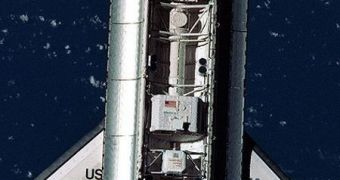When NASA created this year's flight manifest for its three-orbiter shuttle fleet, it decided to use Endeavor to deliver one of the most expensive and advanced pieces of scientific equipment ever flown to space to the International Space Station (ISS). The flight was initially scheduled on July 29, but now officials at the agency announce that the flight will most likely take place in November. Delaying the flight is meant to give engineers working with the $1.5 billion experiment the time they need to make last-minute modifications, Space reports.
The Alpha Magnetic Spectrometer (AMS) is the most advanced experiment to ever be delivered to the ISS. Once mounted to the outer hull of the station, in a special docking berth, the massive particle detector will begin looking for antimatter and dark matter particles coming in from space, by analyzing high-energy cosmic rays hitting it. However, it was made obvious in recent tests that the superconducting magnet at the core of the AMS was overheating during normal work conditions. Since replacing it with another would have been too complicated, the team of engineers in charge of getting the AMS ready to fly decided to place a permanent, longer-lasting magnet inside.
The move will make the detector less sensitive to the particles it needs to analyze, but it will allow for it to endure in space longer. Astrophysicists hope that the trade-off will eventually work in their favor, given that otherwise that spectrometer could only function for 2 years aboard the ISS, rather than the planned four or more. “Given that the [space station program] has been extended, the permanent magnet gives them a much longer science mission than the cryo-magnet. From a thermal challenge standpoint, I think they'll get a lot better science out of this other magnet,” said last week the NASA director of shuttle integration, Mike Moses.
With Endeavor's launch pushed back, the flight manifest changes considerably. The space shuttle Discovery, scheduled for lift-off in September, will not be the last flight of a NASA orbiter. Atlantis is still on track for its May 14 launch, in the STS-132 mission. This will mark its last flight. Discovery's STS-134 mission will mark its final flight as well. However, NASA officials announce that a number of delays could appear in this launch schedule. Discovery's take-off may also be delayed to some extent, due to some potential delays in processing its cargo.

 14 DAY TRIAL //
14 DAY TRIAL //